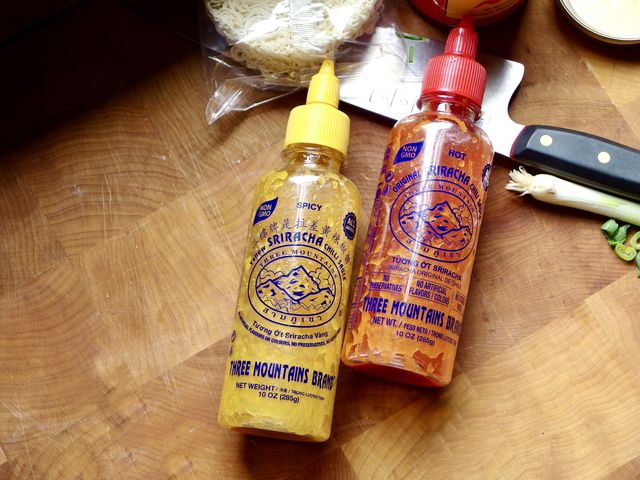Sriracha, a fiery red sauce with Thai and Vietnamese roots, is everywhere these days: on McDonald's burgers, Chik-fil-A sandwiches, Starbucks' hot foods, positioned alongside ketchup in classic diners and in the cabinets of nearly every American kitchen. That's because it was born here — a creation of David Tran, who is of Chinese heritage, but was born in Vietnam, in the mid-80s.
Chan based his recipe, which he called "rooster sauce," on sauces served in Si Racha, a coastal town in Thailand. (Popular reporting states it can be traced back to Ms. Thanom Chakkapak at Trok Laem Fan.) The ingredient list is short — chili peppers, vinegar, garlic, salt and sugar — and the name is by no means trademarked. That's why everyone from the execs at Chik-fil-A to the folks at, say, Pizza Hut can capitalize on its IP.
But, despite its ever-growing popularity with everyone else, Tran says he made the sauce for people like him.
"I made this sauce for the Asian community," he told The New York Times in 2009. Once he'd settled on his formula, though, he knew it could become something big — something that could compete with ketchup. "I knew, after the Vietnamese resettled here, that they would want their hot sauce for their pho. But I wanted something that I could sell to more than just the Vietnamese."
His efforts turned "rooster sauce" — recognizable by its bright green cap, thick red contents and the illustrated rooster, which he sells through his company, Huy Fong Foods — into what is by and large the world's biggest sriracha brand. It's still made here in the United States, though, using red jalapeno peppers — they're red because they're harvest later in the season; prematurely picked jalapenos are green — that are grown close by in California. They give the sauce its edge: a pungent, precise punch of pepper-induced heat comparable to sambal, but with less funk.
For most folks, Huy Fong's sriracha is simply sriracha, the way Kleenex are kleenex. And to be honest, it's fair of them to assume it's the only one. Because the name itself is not trademarked, anyone can call the sauce they make sriracha, even if it isn't Tran's.
That's worked for and against him, in my opinion. On one hand, it's made licensing his brand a breeze, because there's a general assumption that all sriracha sauces are his. On the other hand, it's opened the door for competitors — both domestic and abroad.
But what if I told you the traditional red stuff's biggest competitor is not another brand, but rather a different colored version made from another type of pepper.
Meet Yellow Sriracha.
More specifically, meet Si Racha-based brand (and farm) Three Mountains' Yellow Sriracha, which the brand sells alongside their own red variety. Besides using Thai burapa chilies rather than red jalapeños, the recipe is quite similar: chilis, sugar, salt and vinegar.
The flavor profiles, though, are not. Yellow sriracha is far sweeter, since it features vinegar made from coconut sugar. This, combined with the burapa pepper's natural punchiness, creates a sauce that passes for citrusy, even though there's absolutely no citrus in there. While I find red sriracha aggressive and overpowering — people use it because they like sriracha, I'd argue, not because it's complementary — yellow sriracha is complex and has more depth to it.
It is technically spicier, though. Traditional sriracha's Scoville levels — a scientific measurement for spiciness — range between 1,000 to 2,500 Scoville. Traditional Thai chiles range from 50,000 to 100,000 Scoville, but Three Mountains's sauce feels far tamer. It's definitely diluted by the salt, sugar and vinegar. (Tabasco, for example, is just 2,000 Scoville. A habanero pepper ranges from 100,000-350,000 Scoville.)
The other noticeable difference between this version and the one we all know, beyond the hue, of course, is that Three Mountains's yellow and red srirachas are made without the preservatives Huy Fong Foods uses: potassium sorbate and sodium bisulfite. Plus, it's free of the common stabilizer xantham gum. These subtractions don't alter the final product, but their omission means Three Mountains' iterations are not shelf-stable. They should be refrigerated after opening.
Folks should find it's just as easy to use — and as quickly, too. It goes well with the same foods the red stuff does and them some.
Of course, whether or not you'll find it your preferred type of sriracha is a matter of personal preference. Korean content creator Gleetz (a.k.a. Gloria) agrees that it's good, but she'd probably stick with red were she forced to choose.
"I actually prefer red sriracha over yellow sriracha," she says. "It's a better companion to meals due to its higher acidity. The yellow sriracha is typically sweeter and it tastes better on its own but, that's not how sauces are intended to be eaten."
"In a really weird way, this tastes kind of like a spicy honey mustard," YouTuber Senpai Kai says. "I love introducing this stuff to people... I'd say it's just as spicy as the red stuff, so if you can find this in stores, it's definitely worth trying."



















